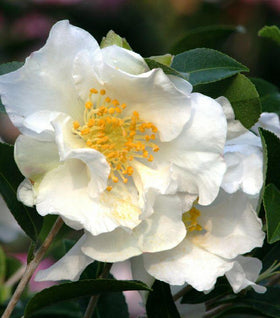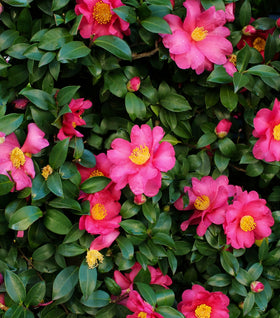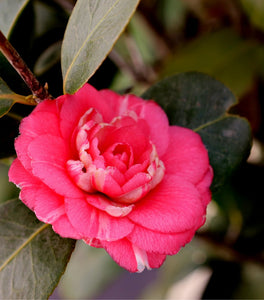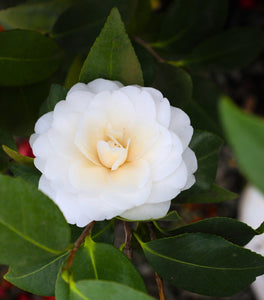Images Depict Mature Plants
Camellia Hana Jiman Shrubs for Sale Online
Camellia Hana Jiman Shrubs produce sizable semi-double flowers in white with a ribbon of pink to the edges. It is a slow-growing, upright-to-spreading shrub. With age, it can become a small tree with oval, glossy leaves and profuse winter-to-spring blooming in milder climates. Camellia Hana Jiman needs acidic well-drained soil and should be planted high (with the trunk base well above the soil line) in a protected environment free from extended heavy freezes.
| Hardiness Zone: | 6-9 |
|---|---|
| Mature Height: | 6 to 8 feet |
| Mature Width: | 4 to 6 feet |
| Classification: | Broad Leaved evergreen shrub, Fall Flowering |
| Sunlight: | Full Sun to Part Shade |
| Habit: | Evergreen, densely branched |
| Flower Color: | White with pink tones, semi-double |
| Foliage: | Dark green |
| Soil Condition: | Any well drained soil |
| Water Requirements: | Water well until established |
| Uses: | Extremely attractive when used as a focal point in the mixed border, mass planting, or a specimen planting. Provides unmatched winter interest due to its flowering in the early winter |

How to Care for Camellia Hana Jiman
Be sure to read our planting instructions to ensure a healthy and happy plant for years to come!
Planting Camellia Hana Jiman Shrubs
We suggest when planting your newly purchased Camellia Hana Jiman plants that you dig a hole twice as wide as the root system but not deeper. Depending on the quality of your existing soil, you may need to add a locally-sourced compost or topsoil to the backfill soil. We do not recommend using straight topsoil or compost as a backfill soil for Camellia Hana Jiman Shrubs because more times than not these products will retain entirely to much moisture and will cause the root system to rot. Adding compost or topsoil will help the young feeder roots of Camellia Hana Jiman spread through the loose, nutrient-rich soil much easier than if you used solely the existing soil, which more times than not will be hard and compacted. The most common cause of plant death after transplanting is planting the new plant too deep. That is why we do not recommend planting in a hole any deeper than the soil line of the plant in the pot. A good rule is that you should still be able to see the soil the plant was grown in after back-filling the hole. Bio-tone starter fertilizer is a great starter fertilizer that provides plants with mycorrhizae fungus. It is a naturally-occurring, beneficial fungus that colonizes on the new growing roots of plants. It creates a barrier between the roots of the plant and fungus and pathogens that can cause root rot. We love this product and use it on all plants we install in our own gardens. Bio-tone is a gardener's best friend and can help guarantee your success.
Watering Camellia Hana Jiman Shrubs
After back filling and lightly compacting the 50/50 mix of existing soil and compost give the Camellia Hana Jiman a good, deep watering. This is not to be rushed. Most of the water you put on the plant at first will run away from the plant until the soil is soaked. A general rule of thumb is to count to 5 for every one gallon of pot size. For example, a one gallon pot would be watered until you count to 5; a three gallon pot would be 15; and so on. Check the plant daily for the first week or so and then every other day there after. Water using the counting method for the first few weeks.












